Cannabis Synthetic Seeds: An Alternative Approach for Commercial Scale of Clonal Propagation and Germplasm Conservation
Abstract
1. Introduction
2. Results and Discussion
2.1. Explant Source, Encapsulation Matrix, and Impact of Storage Temperature on Synseed Viability
2.2. Impact of Light on Cannabis Synseeds Viability and Regrowth Rates
2.3. Acetylsalicylic Acid Conditionally Alters Regrowth Rate of Cannabis Synseed
2.4. ASA Improves Regrowth Vigor of Dark Stored Synseeds
2.5. Rooting and Establishment of Synseed Shoots
3. Materials and Methods
3.1. Plant Material and Environmental Conditions
3.2. Explant Preparations
3.3. Encapsulation Matrix
3.4. Storage of Encapsulated Seeds and Treatments
3.5. Regrowth of Cannabis Encapsulated Seeds and Data Collection and Analysis
4. Conclusions
Supplementary Materials
Author Contributions
Funding
Data Availability Statement
Acknowledgments
Conflicts of Interest
References
- The Global Cannabis Report: Growth & Trends Through 2025. 2021. Available online: https://newfrontierdata.com (accessed on 12 August 2022).
- Wartenberg, A.C.; Holden, P.A.; Bodwitch, H.; Parker-Shames, P.; Novotny, T.; Harmon, T.C.; Hart, S.C.; Beutel, M.; Gilmore, M.; Hoh, E.; et al. Cannabis and the Environment: What Science Tells Us and What We Still Need to Know. Environ. Sci. Technol. Lett. 2021, 8, 98–107. [Google Scholar] [CrossRef]
- Small, E. Evolution and classification of Cannabis sativa (marijuana, hemp) in relation to human utilization. Bot. Rev. 2015, 81, 189–294. [Google Scholar] [CrossRef]
- Maurya, N.; Velmurugan, B.K. Therapeutic applications of cannabinoids. Chem. Biol. Interact. 2018, 293, 77–88. [Google Scholar] [CrossRef] [PubMed]
- Van Breemen, R.B.; Muchiri, R.N.; Bates, T.A.; Weinstein, J.B.; Leier, H.C.; Farley, S.; Tafesse, F.G. Cannabinoids Block Cellular Entry of SARS-CoV-2 and the Emerging Variants. J. Nat. Prod. 2022, 85, 176–184. [Google Scholar] [CrossRef]
- Monthony, A.S.; Page, S.R.; Hesami, M.; Jones, A.M.P. The past, present and future of Cannabis sativa tissue culture. Plants 2021, 10, 185. [Google Scholar] [CrossRef]
- Chandra, S.; Lata, H.; ElSohly, M.A.; Walker, L.A.; Potter, D. Cannabis cultivation: Methodological issues for obtaining medical-grade product. Epilepsy Behav. 2017, 70, 302–312. [Google Scholar] [CrossRef]
- Punja, Z.K.; Collyer, D.; Scott, C.; Lung, S.; Holmes, J.; Sutton, D. Pathogens and Molds Affecting Production and Quality of Cannabis sativa L. Front. Plant Sci. 2019, 10, 1120. [Google Scholar] [CrossRef]
- Punja, Z.K. Epidemiology of Fusarium oxysporum causing root and crown rot of cannabis (Cannabis sativa L., marijuana) plants in commercial greenhouse production. Can. J. Plant Pathol. 2020, 43, 216–235. [Google Scholar] [CrossRef]
- Adhikary, D.; Kulkarni, M.; El-Mezawy, A.; Mobini, S.; Elhiti, M.; Gjuric, R.; Ray, A.; Polowick, P.; Slaski, J.J.; Jones, M.P.; et al. Medical cannabis and industrial hemp tissue culture: Present status and future potential. Front. Plant Sci. 2021, 3, 627240. [Google Scholar] [CrossRef] [PubMed]
- Micheli, M.; Standardi, A. From Somatic Embryo to Synthetic Seed in Citrus spp. Through the Encapsulation Technology. In In Vitro Embryogenesis in Higher Plants, Methods in Molecular Biology; Germana, M., Lambardi, M., Eds.; Humana Press: New York, NY, USA, 2016; pp. 515–522. [Google Scholar] [CrossRef]
- Bekheet, S.A. Encapsulation of Date Palm Somatic Embryos: Synthetic Seeds. In Date Palm Biotechnology Protocols. Methods in Molecular Biology; Al-Khayri, J., Jain, S., Johnson, D., Eds.; Humana Press: New York, NY, USA, 2017; Volume II, pp. 71–78. [Google Scholar] [CrossRef]
- Chand, S.; Singh, A.K. Plant regeneration from encapsulated nodal segments of Dalbergia sissoo Roxb., a timber-yielding leguminous tree species. J. Plant Physiol. 2004, 161, 237–243. [Google Scholar] [CrossRef]
- Lata, H.; Chandra, S.; Khan, I.A.; ElSohly, M.A. Propagation through alginate encapsulation of axillary buds of Cannabis sativa L. An important medicinal plant. Physiol. Mol. Biol. Plants 2009, 15, 79–86. [Google Scholar] [CrossRef]
- Hirai, D.; Sakai, A. Cryopreservation of in vitro-grown axillary shoot-tip meristems of mint (Mentha spicata L.) by encapsulation vitrification. Plant Cell Rep. 1999, 19, 150–155. [Google Scholar] [CrossRef] [PubMed]
- Benelli, C. Encapsulation of Shoot Tips and Nodal Segments for In Vitro Storage of “Kober 5BB” Grapevine Rootstock. Horticulturae 2016, 2, 10. [Google Scholar] [CrossRef]
- Gantait, S.; Vijayan, J.; Majee, A. Artificial Seed Production of Tylophora indica for Interim Storing and Swapping of Germplasm. Hort. Plant J. 2017, 3, 41–46. [Google Scholar] [CrossRef]
- Prakash, A.V.; Nair, D.S.; Alex, S.; Viji, M.M.; Reghunath, B.R. Calcium alginate encapsulated synthetic seed production in Plumbago rosea L. for germplasm exchange and distribution. Physiol. Mol. Biol. Plants 2018, 24, 963–971. [Google Scholar] [CrossRef] [PubMed]
- Trejo-Tapia, G.; León-Romero, Y.; Montoya-Medina, E.B.; López-Laredo, A.R.; Trejo-Espino, J.L. Perspectives of Synthetic Seed Technology for Conservation and Mass Propagation of the Medicinal Plant Castilleja tenuiflora Benth. In Synthetic Seeds, Germplasm Regeneration, Preservation and Prospects; Faisal, M., Alatar, A., Eds.; Springer: Cham, Switzerland, 2019; pp. 335–346. [Google Scholar] [CrossRef]
- Ekinci, H.; Çiftçi, Y.Ö.; Nadarajan, J. Medium- and Long-Term Conservation of Ornamental Plants Using Synthetic Seed Technology. In Synthetic Seeds, Germplasm Regeneration, Preservation and Prospects. Faisal, M., Alatar, A., Eds.; Springer: Cham, Switzerland, 2019; pp. 335–346. [Google Scholar] [CrossRef]
- Hung, C.D.; Trueman, S.J. Alginate encapsulation of shoot tips and nodal segments for short-term storage and distribution of the eucalypt Corymbia torelliana × C. citriodora. Acta Physiol. Plant. 2011, 34, 117–128. [Google Scholar] [CrossRef]
- Lee, J.G.; Yi, G.; Choi, J.H.; Lee, E.J. Analyses of targeted/untargeted metabolites and reactive oxygen species of pepper fruits provide insights into seed browning induced by chilling. Food Chem. 2020, 332, 127406. [Google Scholar] [CrossRef]
- Herrera-Vásquez, A.; Salinas, P.; Holuigue, L. Salicylic acid and reactive oxygen species interplay in the transcriptional control of defense genes expression. Front. Plant Sci. 2015, 6, 171. [Google Scholar] [CrossRef]
- Miura, K.; Tada, Y. Regulation of water, salinity, and cold stress responses by salicylic acid. Front. Plant Sci. 2014, 5, 4. [Google Scholar] [CrossRef]
- Lata, H.; Chandra, S.; Techen, N.; Khan, I.A.; ElSohly, M.A. Molecular analysis of genetic fidelity in Cannabis sativa L. plants grown from synthetic (encapsulated) seeds following in vitro storage. Biotechnol. Lett. 2011, 33, 2503–2508. [Google Scholar] [CrossRef]
- Lata, H.; Chandra, S.; Mehmadic, Z.; Khan, I.A.; ElSohly, M.A. In vitro Germplasm Conservation of High THC Yielding Elite Clones of Cannabis sativa L. under Slow Growth Conditions. Planta Med. 2011, 77, 3. [Google Scholar] [CrossRef]
- Sharma, S.; Shahzad, A. Encapsulation technology for short-term storage and conservation of a woody climber, Decalepis hamiltonii Wight and Arn. Plant Cell Tissue Organ Cult. 2012, 111, 191–198. [Google Scholar] [CrossRef]
- Banerjee, S.; Singh, S.; Pandey, H.; Pandey, P.; ur Rahman, L. Conservation and storage of Curcuma amada Roxb. synseeds on Luffa sponge matrix and RAPD analysis of the converted plantlets. Ind. Crops Prod. 2012, 36, 383–388. [Google Scholar] [CrossRef]
- Marino, G.; Negri, P.; Cellini, A.; Masia, A. Effect of carbohydrates on in vitro low-temperature storage of shoot cultures of apricot. Sci. Hortic. 2010, 126, 434–440. [Google Scholar] [CrossRef]
- Padilla, I.M.G.; Barba-Espín, G.; Hernández, J.A.; Piqueras, A.; Burgos, L. Acetylsalicylic acid improved antioxidative status and cold storage of encapsulated nodal segments of neem (Azadirachta indica A. Juss.). Plant Cell Tissue Organ Cult. 2021, 144, 261–270. [Google Scholar] [CrossRef]
- Lukatkin, A.S.; Brazaityte, A.; Bobinas, C.; Duchovskis, P. Chilling injury in chilling-sensitive plants: A review. Agriculture 2012, 99, 111–124. [Google Scholar]
- Kamińska, M.; Skrzypek, E.; Wilmowicz, E.; Tretyn, A.; Trejgell, A. Effect of light conditions and ABA on cold storage and post-storage propagation of Taraxacum pieninicum. Plant Cell Tissue Organ Cult. 2016, 127, 25–34. [Google Scholar] [CrossRef]
- Kamińska, M.; Gołębiewski, M.; Tretyn, A.; Trejgell, A. Efficient long-term conservation of Taraxacum pieninicum synthetic seeds in slow growth conditions. Plant Cell Tissue Organ Cult. 2018, 132, 469–478. [Google Scholar] [CrossRef]
- West, T.P.; Ravindra, M.B.; Preece, J.E. Encapsulation, cold storage, and growth of Hibiscus moscheutos nodal segments. Plant Cell Tissue Organ Cult. 2006, 87, 223–231. [Google Scholar] [CrossRef]
- Magagnini, G.; Grassi, G.; Kotiranta, S. The Effect of Light Spectrum on the Morphology and Cannabinoid Content of Cannabis sativa L. Med. Cannabis Cannabinoids 2018, 1, 19–27. [Google Scholar] [CrossRef]
- Senaratna, T.; Touchell, D.; Bunn, E.; Dixon, K. Acetylsalicylic acid (Aspirin) and salicylic acid induce multiple stress tolerance in bean and tomato plants. Plant Growth Regul. 2000, 30, 157–161. [Google Scholar] [CrossRef]
- Abd Alhady, M.R.A. In Vitro Plant Regeneration from Alginate Encapsulated Shoot Tips of Casimairoa Edulis L. Egypt. J. Desert Res. 2017, 67, 315–325. [Google Scholar]
- Katouzi, S.S.S.; Majd, A.; Fallahian, F.; Bernard, F. Encapsulation of shoot tips in alginate beads containing salicylic acid for cold preservation and plant regeneration in sunflower (Helianthus annuus L.). Aust. J. Crop Sci. 2011, 5, 1469–1474. [Google Scholar]
- Zarei, A.; Behdarvandi, B.; Tavakouli Dinani, E.; Maccarone, J. Cannabis sativa L. photoautotrophic micropropagation: A powerful tool for industrial scale in vitro propagation. In Vitro Cell. Dev. Biol.-Plant 2021, 57, 932–941. [Google Scholar] [CrossRef]
- Zarei, A.; Davis, B.; Feyissa, B.; Tavakouli Dinani, E.; Simons, B. Improvement of mineral nutrition and rooting efficiency of Cannabis sativa L. for in vitro large-scale propagation. In Vitro Cell. Dev. Biol.-Plant, 2022; in press. [Google Scholar]
- R Core Team. R: A Language and Environment for Statistical Computing; R Foundation for Statistical Computing: Vienna, Austria, 2022; Available online: https://www.R-project.org/ (accessed on 20 October 2022).
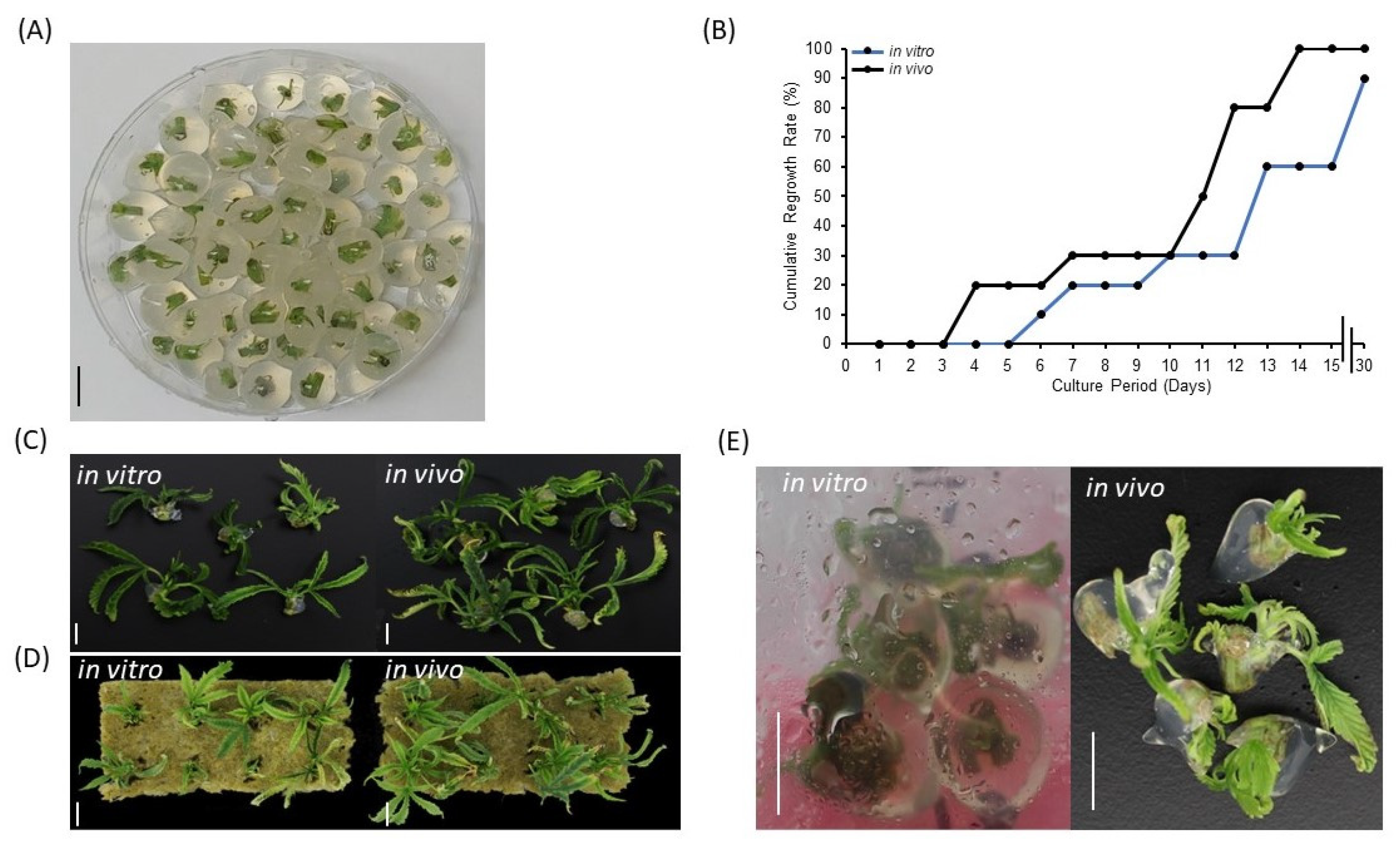
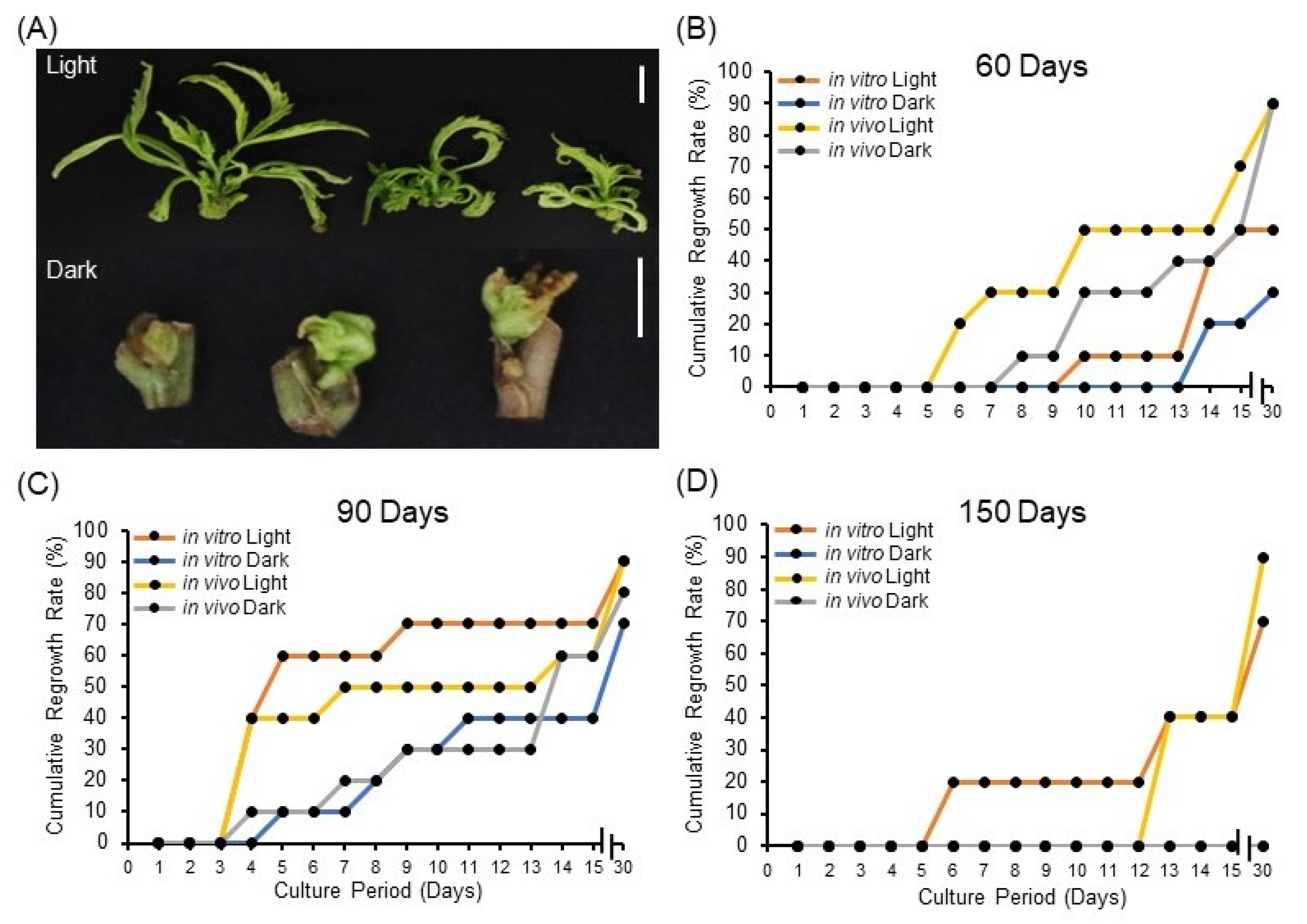
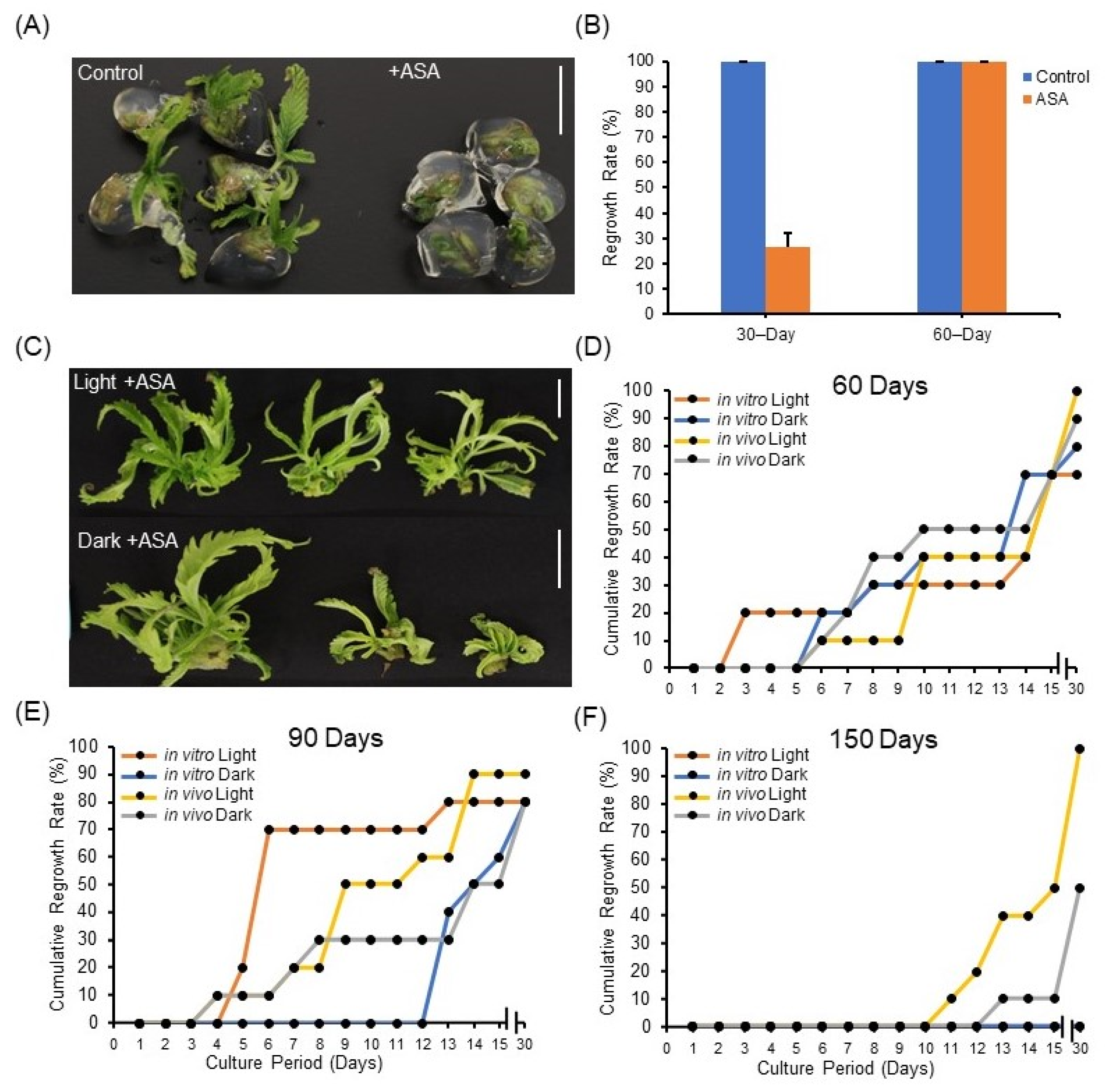
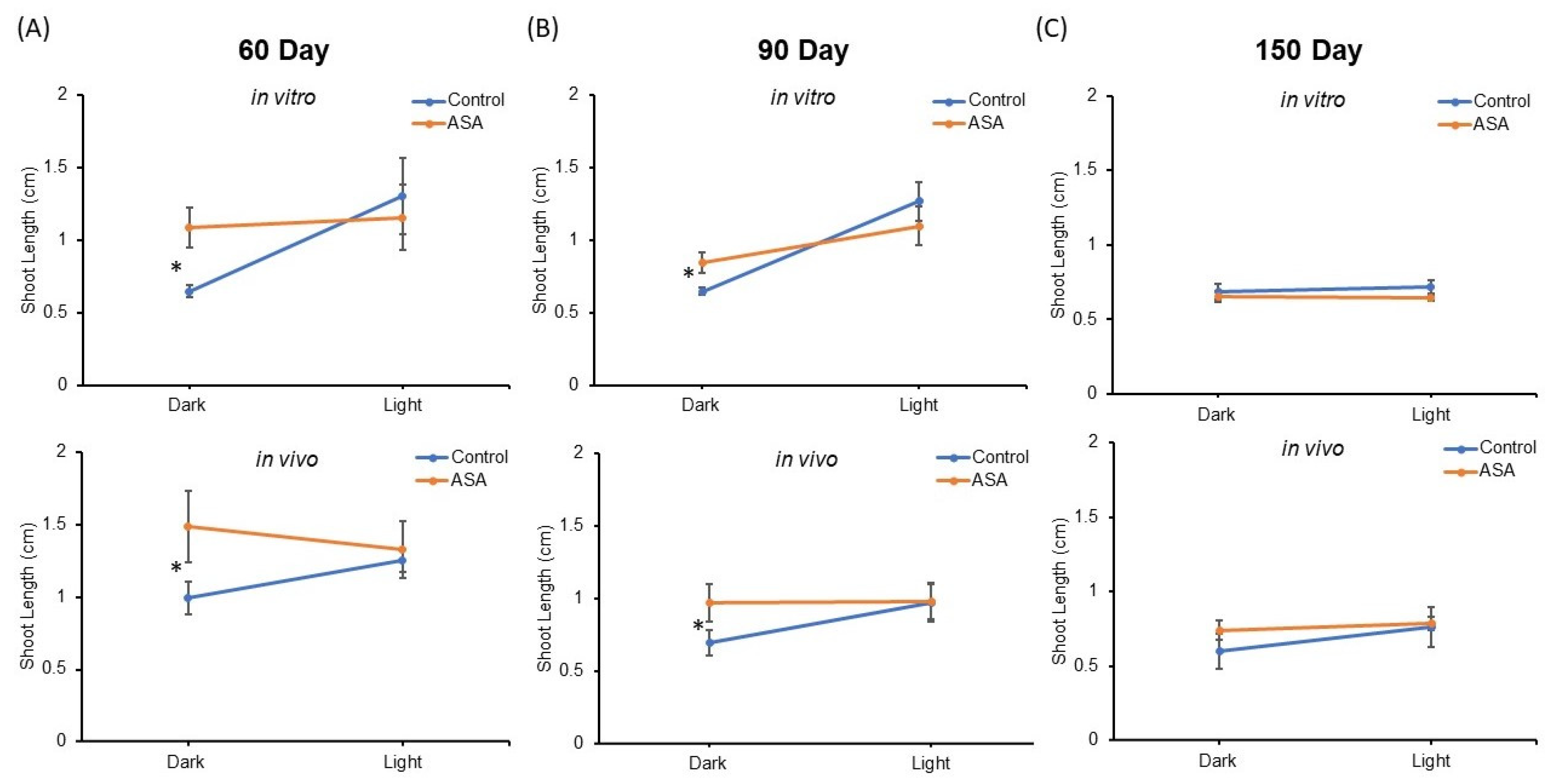
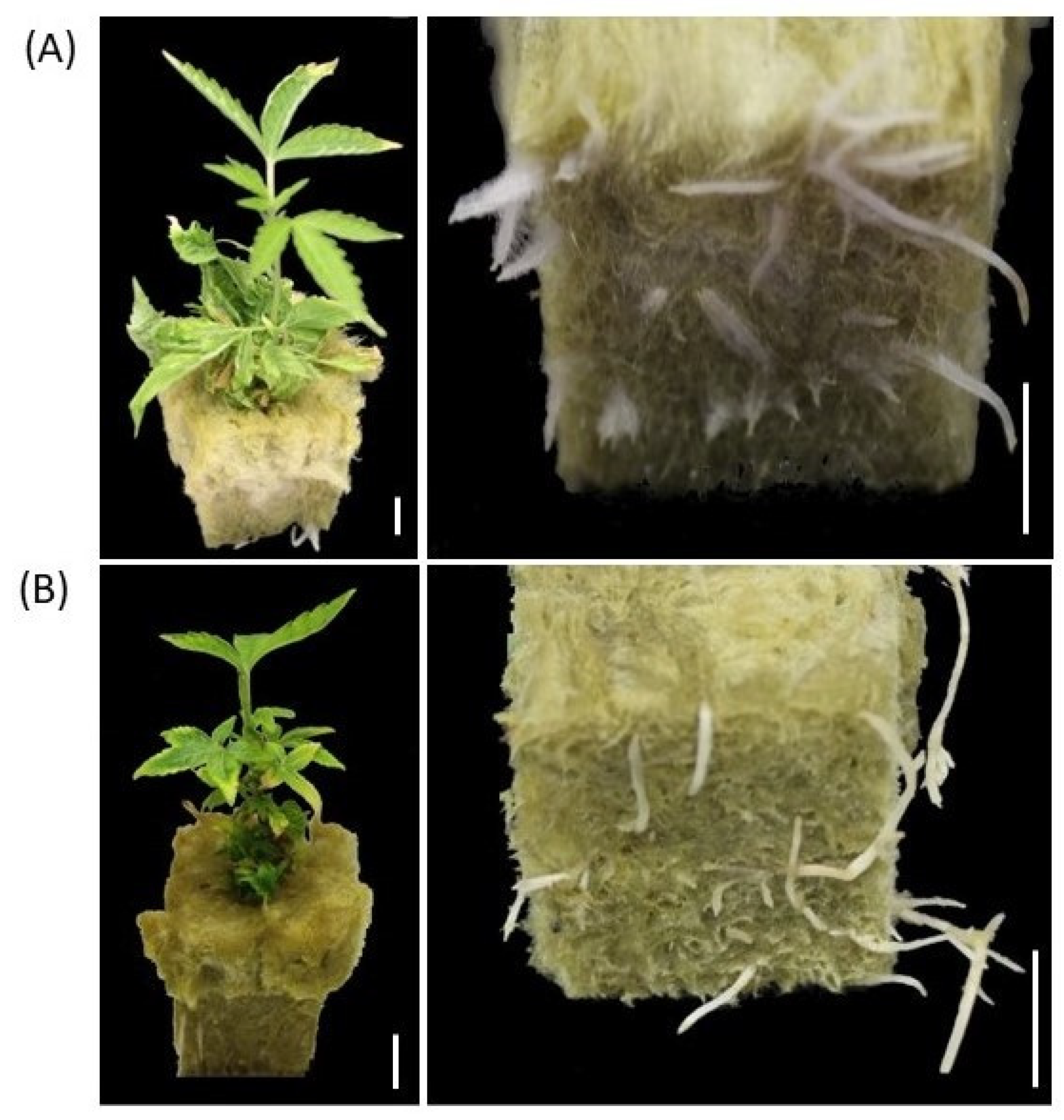
Publisher’s Note: MDPI stays neutral with regard to jurisdictional claims in published maps and institutional affiliations. |
© 2022 by the authors. Licensee MDPI, Basel, Switzerland. This article is an open access article distributed under the terms and conditions of the Creative Commons Attribution (CC BY) license (https://creativecommons.org/licenses/by/4.0/).
Share and Cite
Zarei, A.; Feyissa, B.A.; Davis, B.; Tavakouli Dinani, E. Cannabis Synthetic Seeds: An Alternative Approach for Commercial Scale of Clonal Propagation and Germplasm Conservation. Plants 2022, 11, 3186. https://doi.org/10.3390/plants11233186
Zarei A, Feyissa BA, Davis B, Tavakouli Dinani E. Cannabis Synthetic Seeds: An Alternative Approach for Commercial Scale of Clonal Propagation and Germplasm Conservation. Plants. 2022; 11(23):3186. https://doi.org/10.3390/plants11233186
Chicago/Turabian StyleZarei, Adel, Biruk A. Feyissa, Benjamin Davis, and Elham Tavakouli Dinani. 2022. "Cannabis Synthetic Seeds: An Alternative Approach for Commercial Scale of Clonal Propagation and Germplasm Conservation" Plants 11, no. 23: 3186. https://doi.org/10.3390/plants11233186
APA StyleZarei, A., Feyissa, B. A., Davis, B., & Tavakouli Dinani, E. (2022). Cannabis Synthetic Seeds: An Alternative Approach for Commercial Scale of Clonal Propagation and Germplasm Conservation. Plants, 11(23), 3186. https://doi.org/10.3390/plants11233186





